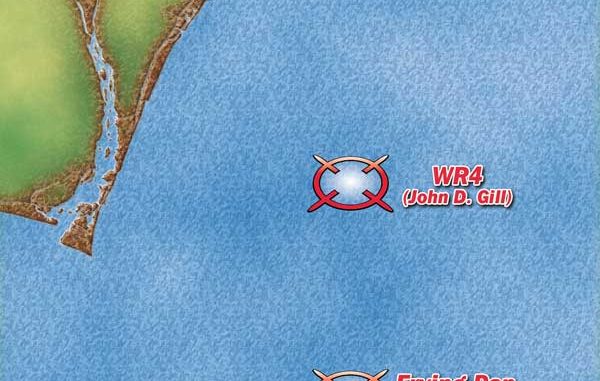
The waters off Wrightsville Beach are among North Carolina’s best to catch the billfish that are jewels in a saltwater angler’s crown.
When fishermen think about sailfish, names such as Acapulco, Cabo San Lucas, Mazatlan, Puerto Vallerta, Costa Rica or Guatemala come to mind.
And there’s nothing wrong with paying air fare and booking a trip to one of those fabulous sailfish capitals. But you don’t need a fat bankroll to challenge these sporty billfish. All you really need is a motel reservation in Wrightsville Beach for a few mid-summer days and a small craft that will handle trips from 10 to 20 miles off the beaches of Pleasure Island.
The waters off Wrightsville Beach and Carolina Beach become “Sailfish Central” during the heat of late July and August. And they have been home to sails for many years — before most fishermen discovered they were out there, just waiting to put on aerial displays that would make Manfred von Richtofen, the “Red Baron,” jealous.
Lee Parsons, a 57-year-old Wilmington native and a veteran guide, has been seeing and fishing for sailfish since the late 1960s.
“I can remember in the late ’60s and early ’70s, going out to WR4 (approximately 24 miles southeast of Wrightsville Beach) and seeing sailfish,” he said.
Parsons believes the Atlantic Ocean off Wrightsville Beach is a nursery area for sailfish.
“I don’t have any proof other than we have caught sailfish from six inches long to 40 pounds out there,” he said.
Once, Parsons said, while trolling big-lipped hard baits for king mackerel, an 8-inch-long sailfish attacked one of the lures and was landed.
“No matter their size, (sailfish) ain’t scared (of lures),” he said. “I had a friend catch one fly-fishing from the surf, and people have caught ’em throwing Got-cha plugs for bluefish from piers.”
When he operated a dive boat in the 1970s, Parsons said he often cast Hopkins spoons off the boat — between dives — and had sailfish attack them.
Parsons’ inshore and offshore fishing platform is the Gottafly, a 23-foot Boston Whaler, which he use for excursions for sails, king mackerel, wahoo and other deepwater denizens, as well as inshore trips for red drum, speckled trout or flounder.
He had that kind of craft in mind when he, Trip Brice and Lee and Kit Taylor created the Eddy Haneman Sailfish Tournament.
“It was originally designed as a small-boat tournament,” Parsons said. “We wanted a billfish tournament the guys with smaller boats could have as much chance to win as the big boats. Somebody with a 16-foot johnboat could win it.”
And he’s proud that small-craft anglers have walked off with most of the top prizes in the annual event, which is July 23-25 this year. Parsons won the sailfish division in 2005 with Dicky Burwell and later captured the dolphin division.
Parsons doesn’t use heavy tackle with which he can haul sailfish straight to the boat, because he likes to see anglers use their skills to land these fish — and he hints he wants to give these beautiful species a chance to outwit and possibly escape the hook.
“Most people use (Shimano) TLD 25 and 30 reels,” he said. “I use Penn 975 and Penn 560 reels,” said Parsons, who also uses Penn saltwater rods. I like the ‘littleness’ of (the tackle). There’s something about catching a big fish on small tackle. You can have fun and sport at the same time.”
The heavy trolling outfits used for tuna, shark, mahi mahi, tarpon, marlin and other billfish that may weigh from 100 to 1,000 pounds. North Carolina sailfish average about 25 to 30 pounds, according to Parsons, whose biggest sail weighed 40 pounds. The state-record, caught in 1987 off Ocean Isle, weighed 100 pounds.
Parsons spools his reels with 20-pound test mono, adds 28 feet of fluorocarbon and ties an additional four feet of fluorocarbon to the end with a snap swivel.
“I do this to be within the legal IGFA (International Gamefish Association) limits,” he said.
At the end, he adds a 7/0 or 8/0 black circle hook. Since 2008, it’s been mandatory for all Atlantic Coast billfish tournament competitors to use circle hooks to prevent billfish from being hooked too deeply and to reduce the delayed mortality associated with J-hooks.
Parsons trolls medium ballyhoo — “Most folks use small ballyhoo,” he said. He prefers “the way they swim” to smaller baits.
“I have all nose-rigged or head-rigged ballyhoo off circle hooks and run as a split bill so they can be skip (surface) baits,” he said.
As for places, Parsons said sailfish locations change daily within a fairly compact swath of ocean off Wrightsville Beach. But it’s a 20-by-20-mile area of water, and sailfish are likely to be anywhere.
“We fish different places because of baitfish locations,” he said. “They change every day. You might find sailfish at one spot one day, and they’ll be somewhere else the next day. There’s no guarantee you’ll catch ’em at the same place day after day; in fact, that’s the least likely thing that’ll happen.
“It’s solely based on currents and winds and that type of things,” he said. “Baitfish that attract sailfish can be from 12 to 20 miles off the beach.
“Baitballs are the big things, though.”
Parsons said that sailfish prey — sardines, alewives or cigar minnows — may orient above bottom structures such as ledges or hard bottoms, but not always. Sometimes they just swim where they want, carried by natural forces.
“One secret is the way the current moves here; if you find baits one day, you fish south of that location the next day,” he said. “There’s a current that moves north to south. It doesn’t have a name, but a lot of guys know about it. So you figure the baits are moving south. We think Cape Fear River currents affect it, too.”
Parsons uses the Furuno fish-finder on his boat’s console to look for submerged bait balls, which are dense collections of baitfish that resemble a ball. Sailfish, in fact, often herd baitfish into tight “balls,” then slash through them to gobble an easy meal.
Parsons’ standard trolling setup includes eight baits. “I can pull eight without outriggers and not tangle my lines,” he said. “Most people who don’t use outriggers only pull five baits.”
Not only that, but Parsons, who has guided serious fly fishermen for years, likes to have his spread close to the boat’s stern so anglers can see sailfish as they approach — and so the fish will be close enough that an angler can pick up a rod and cast a fly to a fish.
“I want everything to be visible so I can see the fish,” he said, “so if (a sailfish) doesn’t take the bait, I can drop back and let the baits fall toward him.”
That’s simply a matter of picking up a rod, putting it in free spool or flipping the bail on a spinning rod and letting a bait that had been skipping on surface begin to flutter and fall toward the ocean floor. Usually a falling bait won’t get far, because few predators can resist the sight of a baitfish that appears wounded dropping right in front of their noses. It’s like dangling a chocolate eclair in front of Rosie O’Donnell.
“If we are too far away, I can’t see the sailfish and won’t know if I need to throttle back,” Parsons said. “That’s why I have a good hookup ratio, I believe. It’s not a bait-and-switch (tactic) like you’d use teasers to get a fish close to a boat then throw a lure of bait at him.”
Parsons said another advantage is that a sailfish, which is naturally wary, won’t feel anything hard in his mouth, like a hook.
“You can let him take the bait (in free-spool) and he can run with it a little, then you set the hook,” he said. “He never knows it’s anything but a dead bait before you hook him up.”
The closest baits in his spread will be 10 feet from the stern, and the most distant will be set about 75 feet back.
“Sometimes a (sailfish) will drop a bait if he feels much pressure,” Parsons said. “So it’s always good, I think, to fish with a light drag, then throw it back up when you want to set the hook. (The angler) is more in control.”
Parsons said the optimal water temperature for sailfish is 76 degrees.
“Actually, it starts when the temperature gets to about 74 degrees,” he said. “But when it reaches 76, that’s when it’s all gonna start happening.”

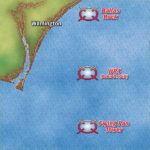
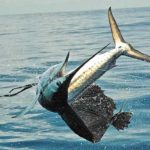
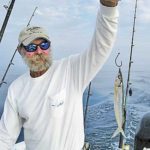

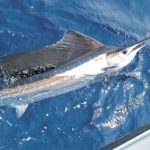
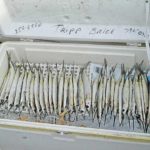
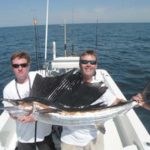



Be the first to comment